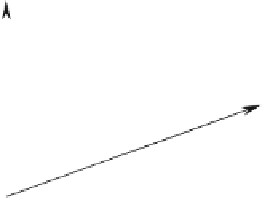Graphics Reference
In-Depth Information
Y
P
2
C
u
P
Z
n
P
3
v
X
d
P
1
Figure 6.25.
We extract two vectors from the triangle
=
−−→
=
−−→
u
P
1
P
2
and
v
P
1
P
3
where
P
1
=
1 0 0 P
2
=
0 2 0 P
3
=
0 0 3
Therefore,
u
=−
i
+
2
j
and
v
=−
i
+
3
k
Calculate
n
:
ijk
n
=
u
×
v
=
−
120
=
6
i
+
3
j
+
2
k
−
103
6
7
i
3
7
j
2
7
k
n
ˆ
=
+
+
and
6
7
x
3
7
y
2
7
z
+
+
=
d
(6.38)
where d is the perpendicular distance from the origin to the plane. We can find d by substituting
P
1
in Eq. (6.38):
6
7
d
=
Using Eq. 6.36, where
=
d
−ˆ
n
·
c
, we have
2
k
6
7
i
7
k
6
7
−
3
7
j
2
=
+
+
·
i
+
j
+
= −
6
7
−
13
7
=
1
=
1













